Maria Júlia is seven years old and is now in the second grade. At school, she loves to play, do her schoolwork, and draw. Her favorite drawings are of horses and ducks. A girl with light skin and hair and brown eyes, she makes a point of saying she is not afraid of the dark, of snakes and not even of tarantulas, the more-than-human beings who often visit her school. Yet there is one thing that makes Maria Júlia stop cold: the “bad men.” “I’m afraid of them because they could set the kids on fire,” she explains, her voice muffled and protected by her mother’s lap and strong embrace. Maria Júlia knows the bad men.
It was not a fantastical story she read that made her afraid of being burned alive. It is life in the Dorothy Stang Resettlement Project, in Anapu, in the state of Pará, in Brazil’s Amazon Rainforest. Late on the night of January 10, the Paulo Anacleto Municipal Primary School was set on fire. Because of how far the school is from the houses, there were no witnesses. Nobody could say who surreptitiously entered the community and set it ablaze.
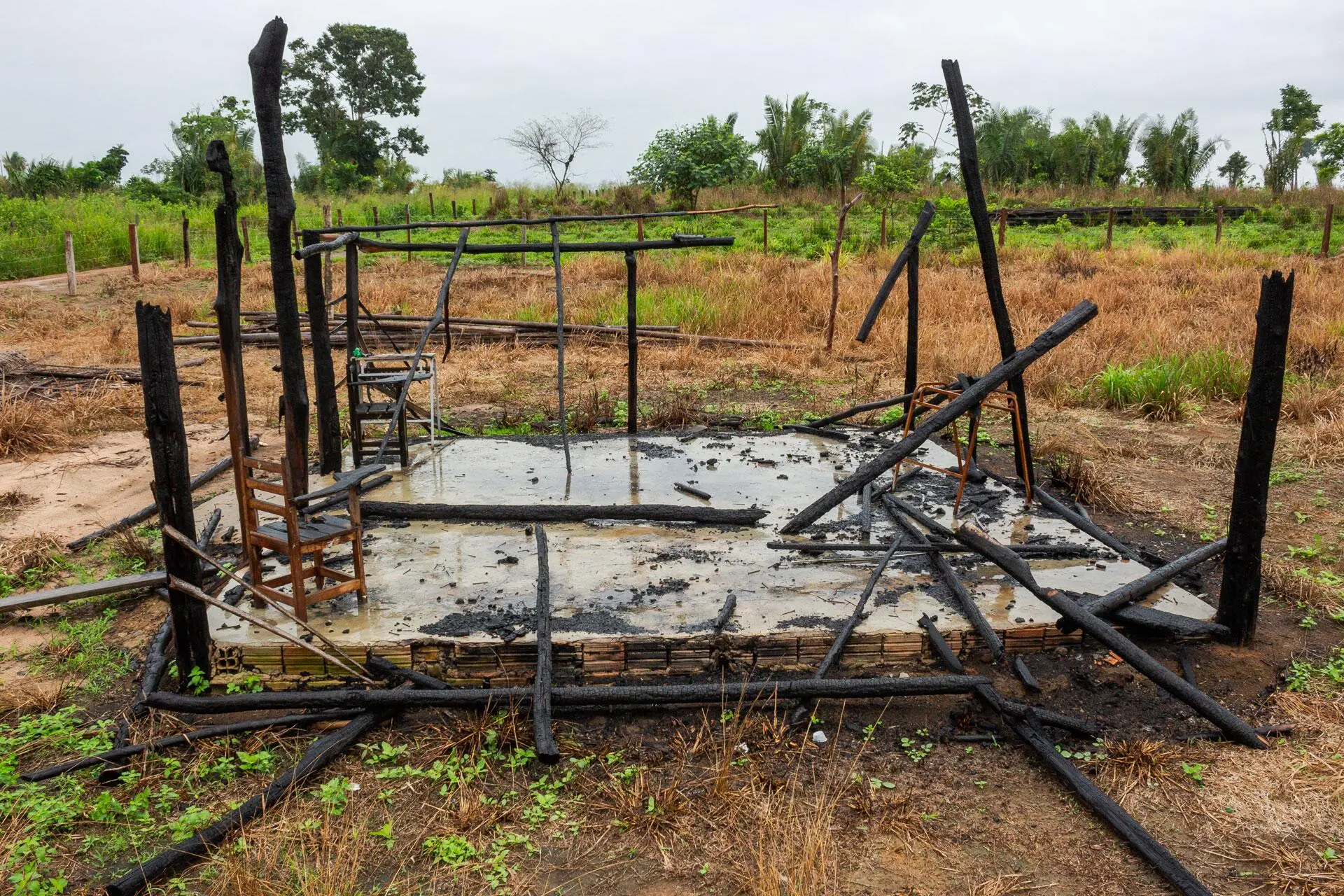
Attack in two acts: the Paulo Anacleto Municipal School was burned down in 2022 and again in 2024, in a gesture of violence to prevent people from remaining on the land
Nothing was left of the place that holds Maria Júlia’s memories of playing with friends. The community had pulled together to build the six-square-meter school out of straw and palm stalks – materials that later allowed the flames to spread faster.
The children’s drawings, hung on the straw wall, turned to ash. All that was left were two wooden and two iron desks. A shed that had been built in the same school area for games of tag and hide and seek was completely destroyed. Only a wooden restroom, built in the back, was spared the brutality. One month after the crime, there is still a perceptible odor of ash.
“Who is bold enough to do this to children?” asks Maria Júlia’s mother, Vanessa Vitoriano, 32. She knows violence is constantly used as a tactic to terrorize the children and residents of Lot 96, the location of the resettlement bearing the name of the missionary murdered on February 12, 2005 in this same municipality. This is the second time that unknown attackers have burned the school down.
Life in the Dorothy Stang Resettlement Project is a daily battle, but the attack on childhood is a recent strategy. A school is one of the main public spaces establishing a community in a place and strengthening ties between families. The recurrent destruction of the school is a tactic aimed at expulsion. It is not the first time. The former leader of Lot 96, Erasmo Theofilo, left the territory several years ago after his children were threatened. He is now in the Protection Program for Defenders of Human Rights, Communicators, and Environmentalists. “You don’t need to worry anymore about dying, because we’re not going to kill you. We’re just going to rip out your heart” – said one of the threatening audio messages Erasmo received over WhatsApp. According to people in the region, to “hit one’s heart” means hitting their kids.
The first act of arson, which also destroyed the Paulo Anacleto School, took place on July 18, 2022. “The first time it was different, they set fire and shot into the air, to really intimidate [us]. This time, no one saw it, we just found the school burned down,” Vanessa recalls. She tells how, in 2022, the residents joined together and in just over ten days built another school out of straw and palm stalks.
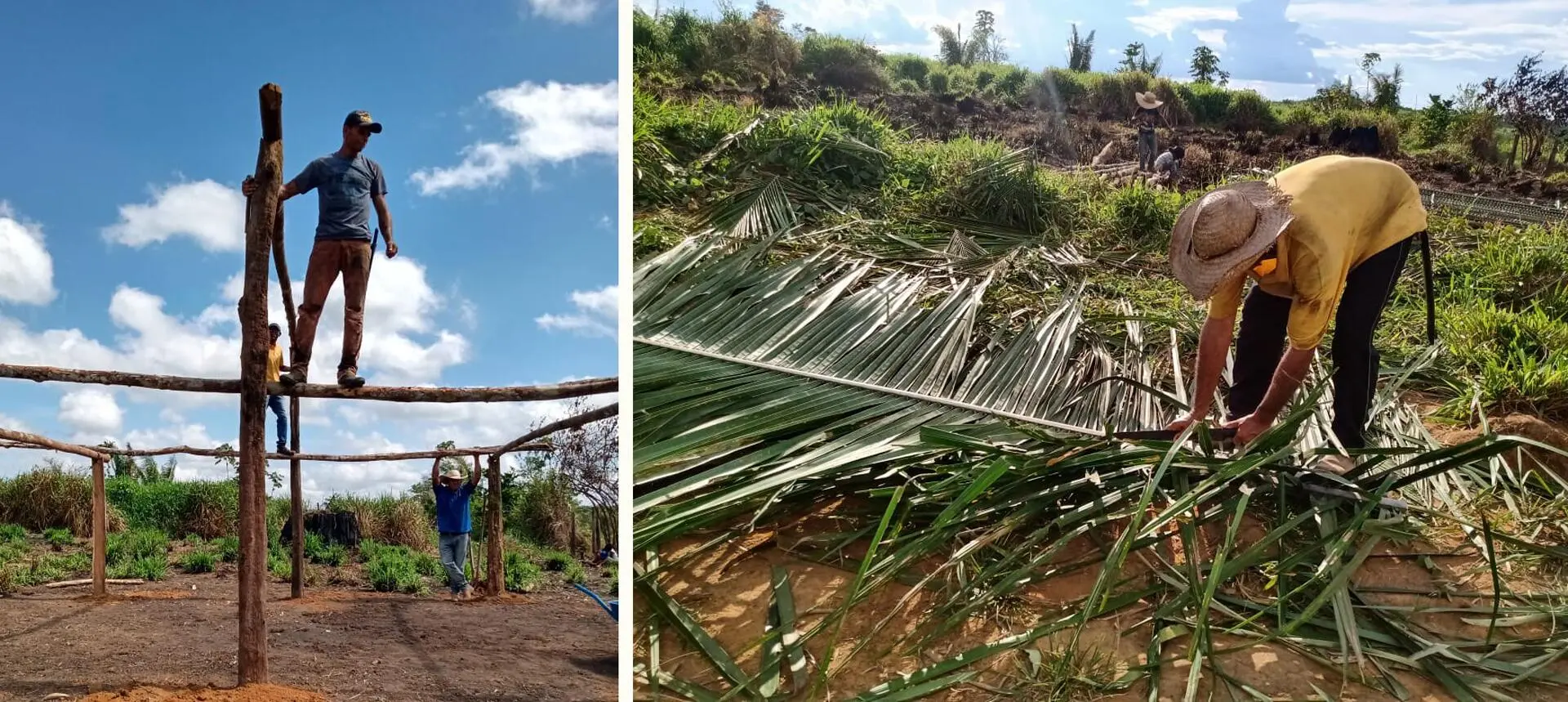
Resistance: two years ago, when the school was burned to ashes the first time, the community rebuilt it in ten days out of palm stalks and straw. Photos: Erasmo Theofilo and Natalha Theofilo
Now, after this tragedy was repeated, the community has received a donation of 10,000 bricks to rebuild another, sturdier school. Yet willpower alone will not be enough. At a January 23 meeting in Anapu with the Altamira Office of the Agrarian Justice Prosecutor, representatives from the State Public Prosecutor’s Office of Pará conveyed the municipal government’s decision to neither build nor refurbish the Paulo Anacleto School, alleging a lack of financial resources and an insufficient number of enrolled students – the minimum should be 25, and there are only 13. Residents submitted a petition to reverse the municipal government’s decision. They have yet to receive a response from public authorities.
In another chapter in its resistance, the community built a makeshift school out of wood in April. The municipal government has told residents informally that the school could open its doors again in August. But for now, these are just promises.
Agnaldo came to Lot 96 thirteen years ago. He dropped out after the ninth grade, after his mother passed away when he was 15 and he had to get a job. “I don’t want my children to have the life I had. How can I give them an education like this? She wants to be a doctor. How?” he asks, tears in his eyes. The day before, while Maria Júlia was playing with her brand new school supplies, she asked Agnaldo: “Dad, am I going to be dumb?” Choked up, he just said to his daughter: “Absolutely not.” Yet the fear is real. The school year was supposed to have started on February 5, but so far no return date has been set for classes.

A dream life: in the face of violence, a student draws the hope of a child who just wants to safely go to school
When asked for comment by SUMAÚMA, neither the municipal government of Anapu nor the Municipal Office of the Education Secretary responded to questions about the educational situation at the resettlement. Only four children began the school year in February, at another school, far from the resettlement. The rest continue to go without classes and without a school. Most of the children have been out of school for four months.
The Civil Police opened inquiries to investigate the two fires at the school, saying investigations are ongoing, but no responsibility has been assigned.
War zone
Anapu resembles a war zone, where people living in resettlements and landless farmers waiting for agrarian reform are violated and intimidated on a daily basis, strategically and systematically deprived of rights until they give up and abandon the territory. The municipality will always be remembered for the murder of 73-year-old missionary Dorothy Stang, killed by gunmen on orders from farmers Vitalmiro Bastos and Regivaldo Galvão. The same greed that cut Dorothy’s life short also sets fires to a school for children.
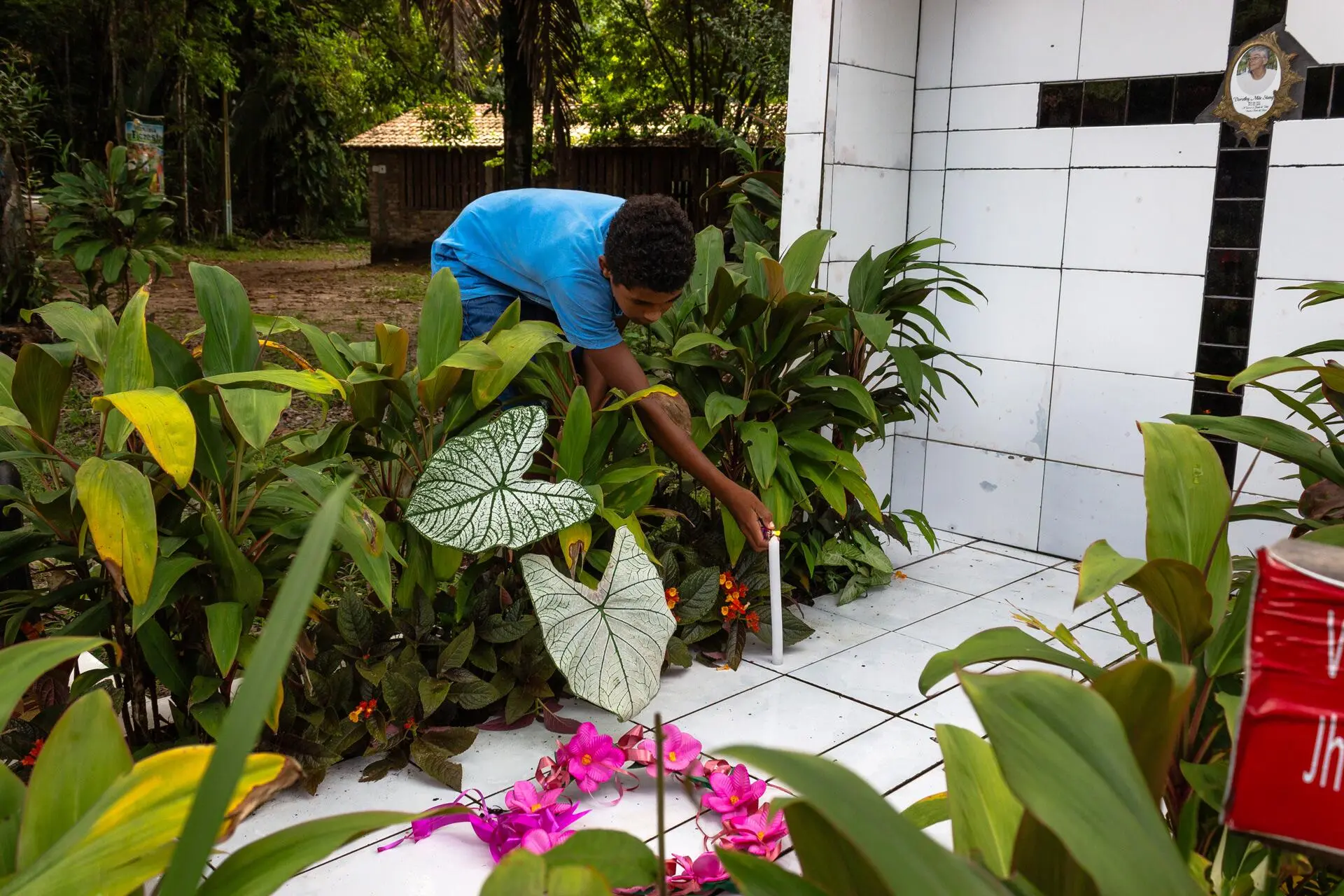
Legacy: a community member lights a candle at the grave of missionary Dorothy Stang, murdered by six gunshots in 2005, by gunmen hired by landgrabbers
According to advance data shown to SUMAÚMA from the Pastoral Land Commission, 29 people were murdered over land conflicts in Anapu from 2005 to 2023. There were, however, no deaths from 2007 to 2014 – executions resumed in 2015, while a crisis was unfolding in the Dilma Rousseff (Workers’ Party) administration that would lead to her impeachment one year later and make Michel Temer (Brazilian Democratic Movement) president. There were six murders in 2023 alone, which are listed as personal conflicts because they happened outside of the resettlement and occupation areas. Yet for the Pastoral Land Commission, they are connected to the fight for land. Killing people outside of the territory is a strategy that gunmen use to hide their motive, commission members told reporters.
By February 2024, the resettlement’s residents had been without electrical power for over a year; the dirt roads were so slippery in some areas during the rainy season that they seemed to be made of clay. Internet and electricity were only accessible for people with solar panels. Today, there is no doctor, and a risk of no longer having a school. The goal is explicit: prevent residents in the Dorothy Stang Resettlement Project, continuing the missionary’s legacy, from remaining on the land.
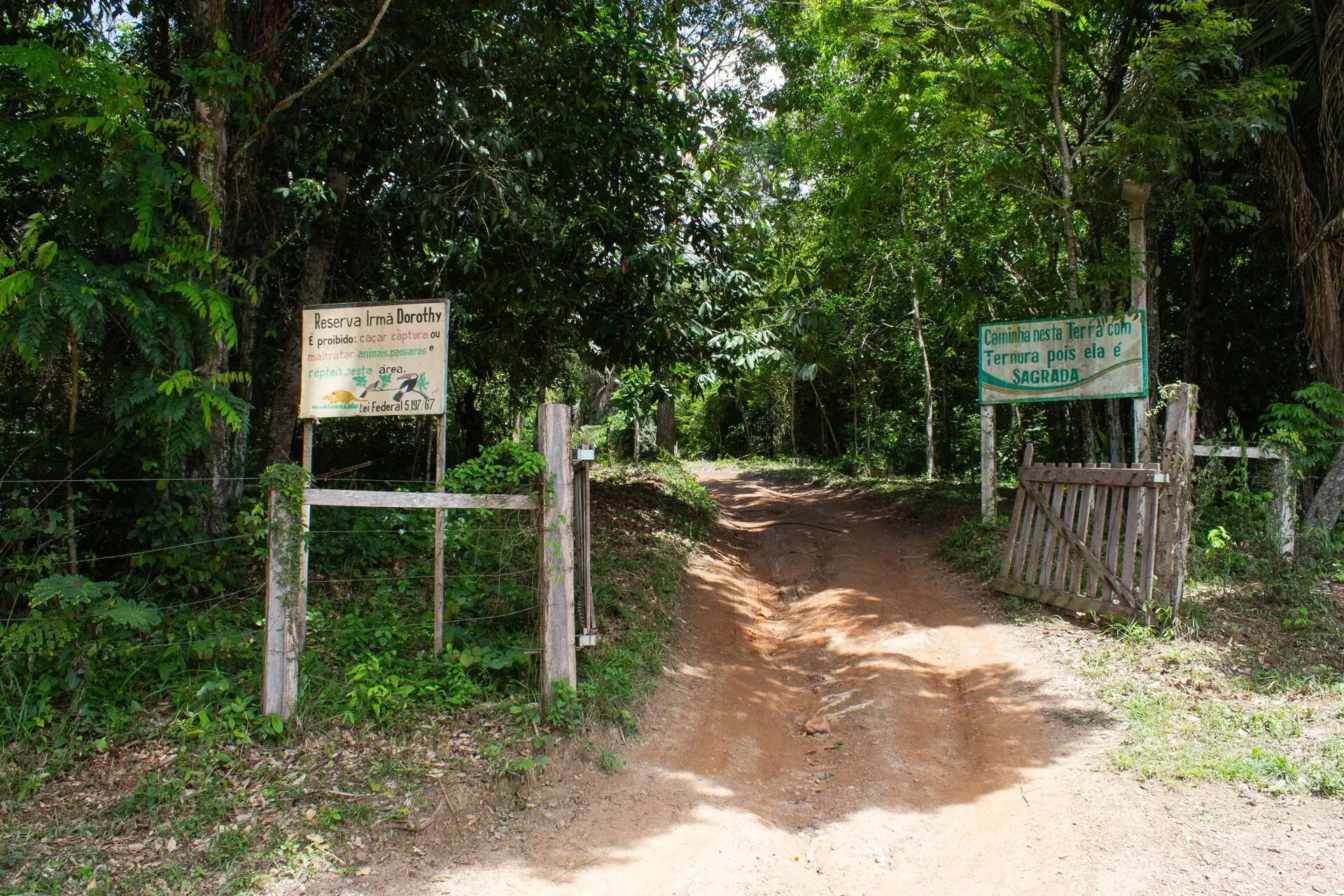
Achievement: nearly 20 years after Dorothy’s death, the resettlement area gained recognition; a memorial honors the nun
The “bad men” responsible for the atrocity of setting fire to the school have used arson to intimidate dozens of families in the last two years. “The first time they set fire here was to a lady’s house. After that, she left, she spent a year being treated for depression, but now she has returned to the territory,” says someone who asked to remain anonymous. “We only made a [police] report about the two school fires and four in resident homes, but we’ve already lost count [of how many attacks have occurred].”
The Federal Public Prosecutor’s Office told SUMAÚMA the investigation into the school fire is confidential.

‘Wherever is necessary’: Raimunda Silva, little Ana Clara’s mom, planted flowers in the resettlement and promises to fight for her daughter’s right to an education
Violence, even in the school’s name
In a place marked by impunity, it is easy to understand why little six-year-old Ana Clara dreams of being a police officer. The black girl with curly hair says that when she grows up, she wants to lock up bad guys who steal and set fire to kids’ schools. “Once I’m a police officer, they’re going to spend months in jail,” she says.
Ana Clara’s family lives in a wood house with a concrete floor, surrounded by impatiens flowers. Raimunda Soares da Silva, 42, Ana Clara’s adoptive mother, says that before coming to the resettlement she lived in Vila Gelado, in the municipality of Novo Repartimento, also in Pará. She brought not only her family, but also various flower seedlings, which now lend color to a place filled with grays. “My brother lived here years before I did and I remember they burned his house down. He went out one day to pick açaí and when he came back it was all on fire.” The tragedy did not stop Raimunda from dreaming about the family’s future in the resettlement. But right now, it is Ana Clara’s future that worries her – and she says she will go “wherever is necessary” to ensure she has an education.

Before the fire: a normal day of school at the resettlement, in 2022. Photo: Mídia Ninja
The Paulo Anacleto School, like everything in the resettlement, was achieved through great struggle. On December 27, 2019, resident Paulo Anacleto adjourned the first official meeting to discuss the school’s creation. He surveyed the families who had kids and, with this data, drew up a document that was taken to the State Public Prosecutor’s Office of Pará, in Anapu, asking the municipal government to create an educational institution.
Erasmo Theofilo, the leader of Lot 96, remembers the story: “This was the start of the process of creating the school. Right after, he was murdered.” Paulo Anacleto was killed later that December of 2019, the date that the exile process began for Erasmo, his partner, Natalha, and their five kids. Under threat, they had to leave the resettlement. The school’s name was a way to honor a fallen comrade. Paulo was murdered five days after another community leader, Márcio Rodrigues dos Reis, was killed after being stabbed in the neck to signal that he “talked too much.” The children live in a resettlement named for a murder victim and are fighting to go to school in a building named for another murder victim. This is the reality of many boys and girls on smallholdings in the Amazon.

On any piece of paper: in drawings by the resettlement’s children, the Paulo Anacleto School still exists, with sun, a rainbow, Birds, rain and even a Giraffe
And there are the kids who already live as refugees in their own country, like the children of defenders who are forced to leave their territory to avoid being killed. Like Erasmo. On December 7, 2020, he was placed in the Protection Program for Defenders of Human Rights, Communicators, and Environmentalists. Today, he and his family are living in forced exile, but they continue fighting, asking the government for changes that can actually protect and guarantee a full life for defenders.
Today, the Paulo Anacleto School only exists as a memory and in the children’s drawings. SUMAÚMA asked students to depict their feelings on paper. In Maria Júlia’s drawing, the school continues intact, with a roof surrounded by a rainbow. Ana Clara insists on putting blue birds in the space that was burned in real life. In João Paulo’s drawing, the classroom is still a sketch, as if he no longer remembered what was there before the fire. The Paulo Anacleto Municipal Elementary School lives in the imagination of all of these children who, even in the face of horror, stubbornly continue to dream.
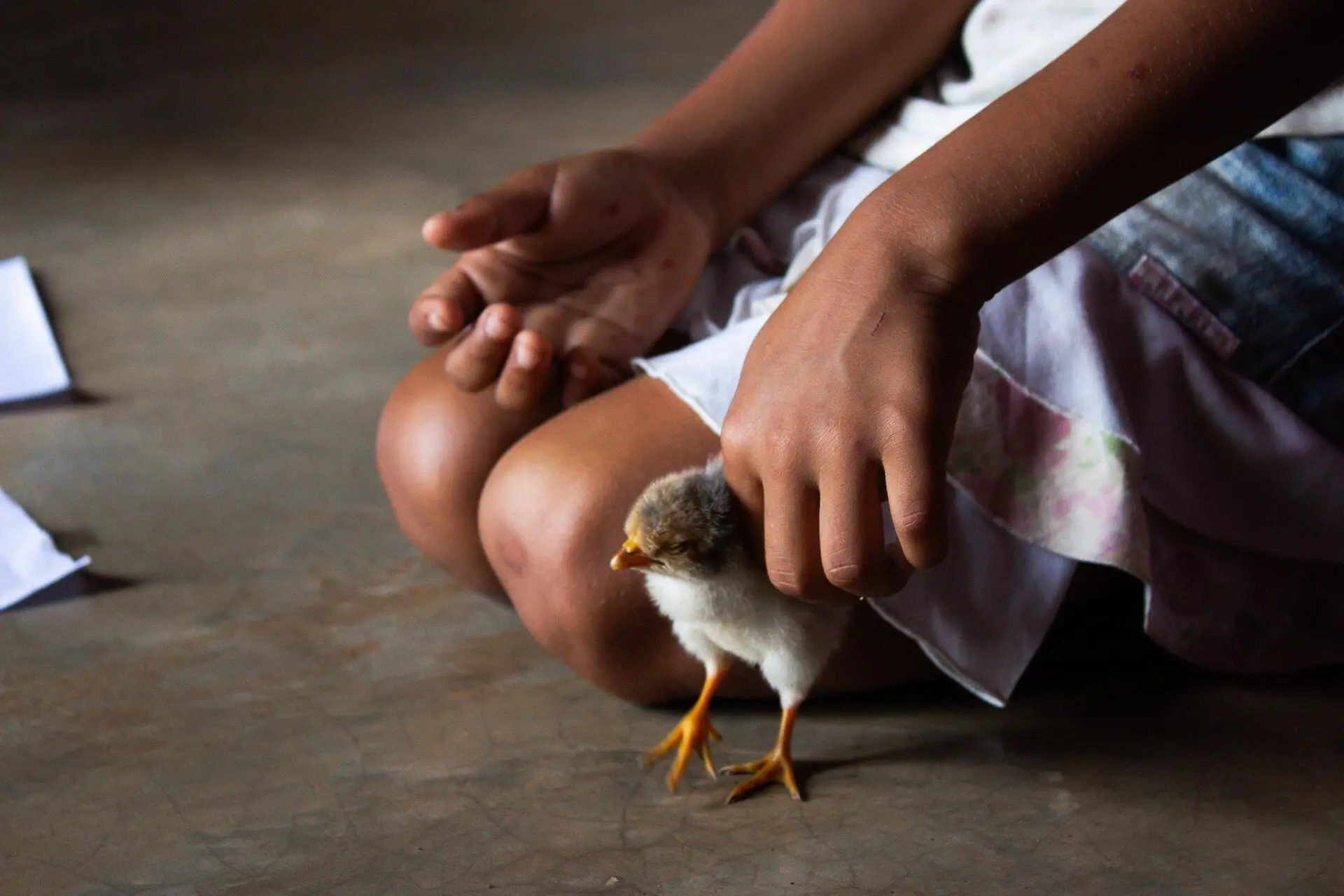
What nobody sees: the kids’ resilience is what guarantees the resettlement’s future, even if rights are constantly being violated
Report and text: Catarina Barbosa
Editing: Malu Delgado and Eliane Brum
Photo Editor: Lela Beltrão
Fact-checker: Plínio Lopes
Proofreader (Portuguese): Valquíria Della Pozza
Spanish translation: Julieta Sueldo Boedo
English translation: Sarah J. Johnson
Copyediting and finishing: Natália Chagas
Editorial workflow coordination: Viviane Zandonadi
News editor: Malu Delgado
Editor-in-chief: Talita Bedinelli
Editorial director: Eliane Brum





